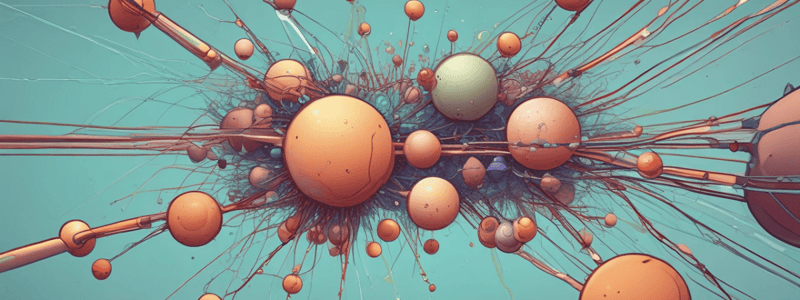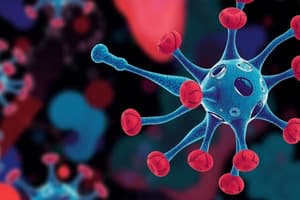Podcast
Questions and Answers
What is the primary mechanism by which drugs interact with their targets?
What is the primary mechanism by which drugs interact with their targets?
- Through intermolecular repulsion
- Through ionic interactions
- Through covalent bonds
- Through intermolecular bonds (correct)
What is the term for specific regions within the binding site involved in binding interactions?
What is the term for specific regions within the binding site involved in binding interactions?
- Active site
- Binding site
- Receptor site
- Binding regions (correct)
What is the term for molecules that bind to receptors and produce a response?
What is the term for molecules that bind to receptors and produce a response?
- Antagonists
- Agonists (correct)
- Activators
- Inhibitors
What is the term for molecules that bind to enzymes, reducing their activity?
What is the term for molecules that bind to enzymes, reducing their activity?
What is the 'lock and key' hypothesis related to?
What is the 'lock and key' hypothesis related to?
What is the term for molecules that bind to receptors, reducing their response?
What is the term for molecules that bind to receptors, reducing their response?
What is the primary function of receptors in cellular function?
What is the primary function of receptors in cellular function?
What is a characteristic of receptors in relation to drugs?
What is a characteristic of receptors in relation to drugs?
What is the term for the process by which a receptor changes its structure in response to binding to a drug?
What is the term for the process by which a receptor changes its structure in response to binding to a drug?
Which of the following is NOT a type of protein target for drugs?
Which of the following is NOT a type of protein target for drugs?
What is the role of enzymes in cellular function?
What is the role of enzymes in cellular function?
What is the purpose of molecular modelling in drug design?
What is the purpose of molecular modelling in drug design?
What is the primary function of an antagonist?
What is the primary function of an antagonist?
What is the difference between competitive and non-competitive antagonists?
What is the difference between competitive and non-competitive antagonists?
What is the effect of an irreversible antagonist on a receptor?
What is the effect of an irreversible antagonist on a receptor?
What is the function of the nicotinic acetylcholine receptor?
What is the function of the nicotinic acetylcholine receptor?
What is the effect of Tubocurarine on the nicotinic acetylcholine receptor?
What is the effect of Tubocurarine on the nicotinic acetylcholine receptor?
What is the definition of a ligand?
What is the definition of a ligand?
Which type of adrenergic receptors is found in adipose tissue?
Which type of adrenergic receptors is found in adipose tissue?
What is the effect of agonists on receptors?
What is the effect of agonists on receptors?
What is the term for compounds that bind to receptors but do not activate them?
What is the term for compounds that bind to receptors but do not activate them?
Which of the following is a characteristic of agonists?
Which of the following is a characteristic of agonists?
What is the effect of binding of an agonist to a receptor?
What is the effect of binding of an agonist to a receptor?
What is the role of endogenous agonists in the body?
What is the role of endogenous agonists in the body?
What is the mechanism of competitive inhibition in enzymes?
What is the mechanism of competitive inhibition in enzymes?
What is the effect of non-competitive inhibition on an enzyme?
What is the effect of non-competitive inhibition on an enzyme?
What type of inhibition can be both competitive and non-competitive?
What type of inhibition can be both competitive and non-competitive?
What is the role of coenzymes in enzyme-catalyzed reactions?
What is the role of coenzymes in enzyme-catalyzed reactions?
What is the result of blocking the enzyme HMG-CoA reductase?
What is the result of blocking the enzyme HMG-CoA reductase?
What is the term for drugs that bind to enzymes and reduce their activity?
What is the term for drugs that bind to enzymes and reduce their activity?
Flashcards
Drug interaction mechanism
Drug interaction mechanism
Drugs interact with their targets primarily through intermolecular bonds.
Binding regions
Binding regions
Specific parts of a binding site where molecules attach.
Agonist
Agonist
A molecule that binds to receptors and starts a response.
Competitive inhibitor
Competitive inhibitor
Signup and view all the flashcards
Lock-and-key hypothesis
Lock-and-key hypothesis
Signup and view all the flashcards
Antagonist
Antagonist
Signup and view all the flashcards
Receptor function
Receptor function
Signup and view all the flashcards
Drug receptor binding
Drug receptor binding
Signup and view all the flashcards
Induced-fit hypothesis
Induced-fit hypothesis
Signup and view all the flashcards
Non-protein drug target
Non-protein drug target
Signup and view all the flashcards
Enzyme function
Enzyme function
Signup and view all the flashcards
Molecular modeling
Molecular modeling
Signup and view all the flashcards
Antagonist function
Antagonist function
Signup and view all the flashcards
Competitive vs. Non-competitive antagonists
Competitive vs. Non-competitive antagonists
Signup and view all the flashcards
Irreversible antagonist
Irreversible antagonist
Signup and view all the flashcards
Nicotinic acetylcholine receptor function
Nicotinic acetylcholine receptor function
Signup and view all the flashcards
Tubocurarine effect
Tubocurarine effect
Signup and view all the flashcards
Ligand
Ligand
Signup and view all the flashcards
Adipose tissue receptor type
Adipose tissue receptor type
Signup and view all the flashcards
Agonist effect on receptors
Agonist effect on receptors
Signup and view all the flashcards
Antagonist structural nature
Antagonist structural nature
Signup and view all the flashcards
Agonists property
Agonists property
Signup and view all the flashcards
Agonist binding effect
Agonist binding effect
Signup and view all the flashcards
Endogenous agonists
Endogenous agonists
Signup and view all the flashcards
Competitive inhibition mechanism
Competitive inhibition mechanism
Signup and view all the flashcards
Non-competitive inhibition effect
Non-competitive inhibition effect
Signup and view all the flashcards
Irreversible inhibition
Irreversible inhibition
Signup and view all the flashcards
Coenzyme role
Coenzyme role
Signup and view all the flashcards
HMG-CoA reductase inhibition
HMG-CoA reductase inhibition
Signup and view all the flashcards
Enzyme inhibitor
Enzyme inhibitor
Signup and view all the flashcards




